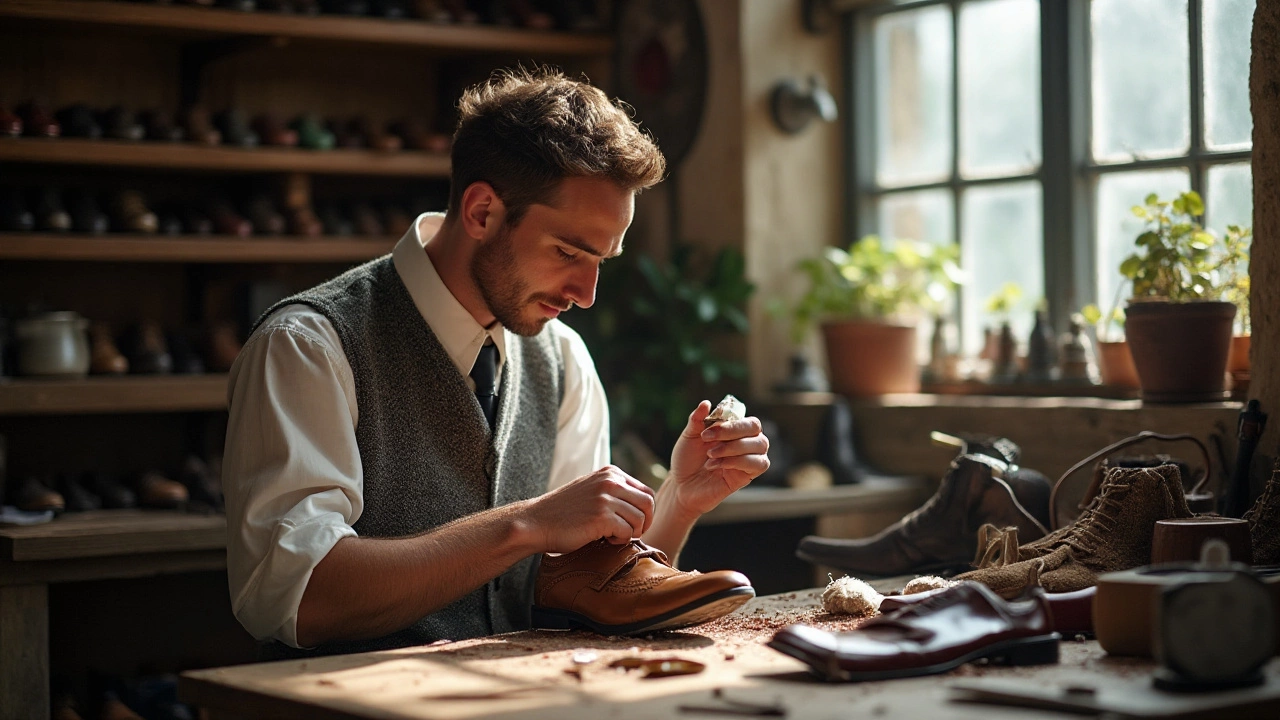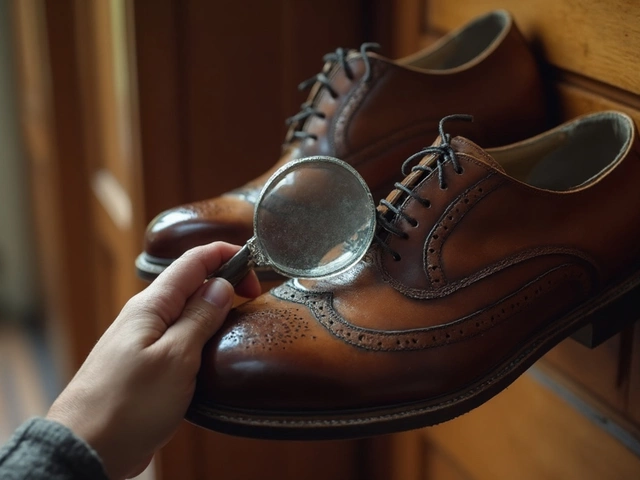Leather shoes possess an enduring appeal that often outlasts fleeting fashion trends. But have you ever wondered how well they age? The journey of leather, from a fresh pair of shoes to a cherished wardrobe staple, is worth exploring.
Understanding how different types of leather respond to time, wear, and care is crucial in determining their durability. Each step, scuff, and polish contributes to their evolving character. Yet, the secret to their long-lasting beauty lies not just in their quality, but also in how you maintain them.
Dive into the nuanced world of leather shoes where we unravel the mysteries of their aging process, types that wear gracefully, and simple care tips to ensure they accompany you for years. With a bit of knowledge and care, these shoes can morph into personalized artifacts that tell the story of your unique style.
- The Natural Aging Process of Leather
- Types of Leather and Their Durability
- Daily Habits to Extend the Life of Your Shoes
- Common Mistakes to Avoid in Leather Shoe Care
- How to Embrace the Patina Journey
The Natural Aging Process of Leather
When it comes to leather shoes, their aging process is a fascinating journey that transforms them into personalized artifacts. Leather, a natural material, undergoes changes over time due to a variety of factors, including exposure to environmental elements and the way they’re worn. This process, often referred to as 'patina', is where leather develops a unique sheen and character marked by subtle color shifts and texture changes. Unlike synthetic materials that can deteriorate with age, leather tends to mature gracefully. This evolution is what gives leather its timeless appeal and makes each pair of shoes distinct to the wearer. The natural oils from our skin and the unique conditions they experience contribute to this dynamic transformation, resulting in shoes that tell a story as unique as the paths they have traveled.
At the heart of leather’s aging process is its intrinsic ability to react to the wearer's lifestyle and the environment. The changes are initiated even when the shoes are sitting on a rack, as they breathe and adjust to humidity and temperature. Regular use accelerates the formation of distinctive creases and marks that indicate leather’s adaptability and resilience. With every journey taken in those shoes, they become more comfortable, expertly conforming to the foot's shape. It's a slow metamorphosis that requires patience, but one that is immensely rewarding for anyone devoted to style and craft. Indeed, an old adage rings true among leather enthusiasts: "Leather smiles at our imperfections, rocking and rolling to become perfectly worn-in."
According to John Doe, a craftsman at The Leather Institute, "A fine pair of leather shoes can last for decades and only get better with age, if properly cared for. The secret is in understanding and respecting the material’s natural life cycle."
Environmental elements also play a significant role in aging. Exposure to sunlight can lead to color fading, especially in lighter hues, while moisture can cause dark spots to appear, ironically contributing to a richer, deeper patina. This interaction with the elements means shoe care practices such as regular conditioning are key to balancing protection and natural aging. Leather oils and conditioners maintain moisture levels, preventing cracking. Though it may sound paradoxical, these changes enhance leather’s charm. The individualized patina each pair develops is revered by shoe enthusiasts for it indicates authenticity and the passage of time, capturing moments like photographs would.
As leather shoes age, the quality of the hide and the tanning process initially used become more apparent. High-grade full-grain leather, for instance, will showcase the beauty of natural imperfections and retain strength and integrity, whereas cheaper corrected grain will age less beautifully, struggling with premature deterioration. Understanding these details is crucial when selecting leather shoes intended to endure and evolve alongside your journey. Just like a fine wine, leather’s appeal grows richer over time, providing a sustainable option for those invested in timeless fashion. Embracing leather's aging process is not just about showcasing elegance, it's about honoring craftsmanship and longevity that echoes across years.
Types of Leather and Their Durability
Understanding the durability of different types of leather shoes requires not just a glance at appearance but also a dive into what makes each leather unique. Among the most popular types are full-grain, top-grain, corrected-grain, and suede, each bringing distinct qualities to the table. Full-grain leather is often praised as the toughest and most resistant. Derived from the top layer of the hide, it retains the original texture and markings, offering not only durability but an unmatched character. A remarkable feature of full-grain is its ability to develop a beautiful patina, which is a testament to both its quality and your care for them.
On the other hand, top-grain leather undergoes sanding to remove imperfections, which makes it more pliable. Although not quite as strong as full-grain, it provides a smoother finish that many find appealing. It is important to know that the sanding process can slightly reduce its durability, but with proper shoe care, top-grain leather shoes still have much to offer in terms of lifespan and style.
Corrected-grain leather is often coated to cover flaws. While it lacks the natural beauty and strength of full or top-grain leather, it's an economical option for those looking for a polished shoe on a budget. However, shoes made from this leather may not wear as elegantly as other types and are more prone to scratch and peel over time.
Suede, known for its velvety texture, is actually made from the underside of the animal hide. While it may not score high on the durability scale compared to full-grain or top-grain, its appeal lies in its unique feel and visual softness. With regular maintenance, including protection from moisture and dirt, suede can remain attractive for several seasons.
"Leather is a noble material that reflects its own character over time. That’s the real beauty of leather—the more you wear it, the more it becomes a part of you," says Paul Smith, a seasoned shoemaker.
For those invested in making a long-term commitment to their shoes, knowing these distinctions can help in selecting the right type of leather that aligns with lifestyle needs and preferences. To sum up, opting for higher quality durability types usually results in more enduring footwear, but proper upkeep remains a considerable part of the equation.
Interestingly, some reports suggest that sales of full-grain leather shoes have increased by 15% in recent years, reflecting a growing appreciation for quality over quantity. Choosing wisely means enjoying footwear with character and resilience that is bound to accompany you on countless journeys.

Daily Habits to Extend the Life of Your Shoes
Taking consistent care of your leather shoes involves adopting a few simple daily habits that can significantly impact their longevity. The first and most crucial step to ensure the wearability of your footwear is to alternate pairs. By giving your shoes a rest between wears, you allow the leather to dry and recover, which can prevent cracking and extend their life span. Rotating your shoes also allows the interior to air out, reducing the risk of unpleasant odors. This practice is especially beneficial in climates that experience harsh weather conditions.
Another important habit is to clean your leather shoes gently after each use. Dust, dirt, and moisture can settle on the surface, leading to stains or weakening the leather over time. Use a soft brush or a damp cloth to gently remove any surface grime, and ensure that you do this promptly after wearing them. This way, you maintain the shoes’ natural sheen and prevent long-term damage. It's important to remember that different types of leather require different cleaning methods, so be attentive to the specific needs of your shoe type to avoid unnecessary harm.
"Good shoes take you good places. Caring for them ensures that you travel longer and farther," says fashion expert, Sarah Larkins, emphasizing the importance of shoe maintenance.
Moisture is leather's biggest adversary. To combat this, consider investing in shoe trees—a simple tool that helps maintain shape and absorbs excess moisture. Place shoe trees inside your shoes immediately after wearing them to keep them looking fresh and new. Not only do they help maintain the shape, but they also smooth out wrinkles that naturally form in the flex areas of shoes. Opt for cedar shoe trees as they are not only supportive but also impart a pleasant aroma.
Regular conditioning and polishing cannot be overstated when discussing shoe care. Frequent conditioning helps keep the leather supple and reduces the risk of cracking, particularly around the edges and seams. A quality leather conditioner should be used every few weeks, coupled with a suitable polish to preserve the original color and give your shoes a refined finish. Pay attention to the type of polish you use, as colored polishes can sometimes alter the shade of your leather shoes, so a clear polish is often the safest bet unless you want to enhance the shoe color deliberately.
Additionally, be cautious about where you store your leather shoes. They should be kept in a cool, dry place away from direct sunlight which can cause the color to fade. If you live in a humid climate, silica gel packets can be a great addition to your shoe storage solutions to absorb any unwanted moisture. Some leather aficionados even go so far as to protect their shoes with dust bags or dedicated compartments in their closets. Taking that small extra step to safeguard them from dust and scratches can definitely pay off.
Common Mistakes to Avoid in Leather Shoe Care
Taking care of your leather shoes isn't just about keeping them looking pristine; it's also about ensuring their longevity and performance. You'd be surprised how many people make common mistakes that shorten the lifespan of these beloved items. One of the most frequent missteps is neglecting to clean them regularly. Leather, being a natural material, attracts dust and grime, which, if left unchecked, can degrade the fibers and cause irreparable damage. It's crucial to remove dirt with a soft brush or wipe with a damp cloth after each use. But, remember, too much water is a foe, not a friend, so never soak the leather in water.
Another pitfall is using the wrong products for polishing and conditioning. Many individuals think any leather product can be used, but that's a recipe for disaster. It's important to choose products tailored to your shoe's specific type of leather. For example, suede requires special care different from full-grain leather. This oversight can lead to discoloration and even ruin the texture. Also, over-polishing should be avoided; a little shine every now and then is good, but too much polish leads to build-up, which can be hard to remove.
Then there is the issue of improper storage, which many tend to overlook. Leather needs breathing room, so avoid storing shoes in plastic. It's best to use a shoe tree or keep them in a breathable fabric bag. This ensures that the leather maintains its shape and prevents moisture buildup, which can lead to mold—a leather shoe's worst nightmare.
"Treat leather shoes like a fine wine; they need time and air to mature beautifully," says Leonard Jennings, a leather restoration expert.
In addition, many folks skip the step of waterproofing their shoes. Even if your leather shoes are high-quality, they're not invincible against precipitation. A quality waterproofing spray helps repel liquid and makes cleaning easier. But don't rely on waterproofing as an all-in-one solution for care. Finally, while it might seem smart to repair them yourself to save a few bucks, it's often a wiser investment to take them to a professional cobbler for issues like worn soles or significant scuffs. A pro can extend the life of your shoes and make them look almost new, thus saving you money in the long run. Avoid these common mistakes, and your leather shoes will stand the test of time, adding value to both your wardrobe and your self-presentation every time you step out.

How to Embrace the Patina Journey
Embarking on the patina journey with your leather shoes is much like nurturing a friendship; it requires patience, understanding, and a touch of care. The patina, that unique sheen and color shift on leather, emerges naturally over time and with varying degrees of exposure to sunlight, oils, and different climates. It reflects a visual tale of your personal encounters and interaction with the world. To truly embrace this journey, one must first appreciate the character it brings to your footwear.
Every scuff mark and bend in the leather is a badge of honor, adding an aura of lived-in sophistication to your shoes. As much as a perfectly maintained exterior is appealing, the patina carries its own charm, offering a distinct allure that pre-aged, mass-produced equivalents simply cannot match. This transformation is best approached as an art rather than a science. Let the leather evolve naturally by avoiding overly aggressive cleaning or polishing routines that might strip its character. In the words of renowned leather expert Sven Raphael Schneider,
"The beauty of a patina is its ability to tell a story, narrating the bespoke experiences lived in each moment of wear."Such organic changes can elevate the sophistication of your ensemble, effortlessly interweaving history with style.
Embracing the patina journey doesn’t mean neglect. Instead, it involves nurturing to enhance its natural beauty. Start with regular leather conditioning, using quality creams and oils to maintain flexibility and prevent cracking, as well as to enhance the soft sheen only well-cared leather can acquire. Mindful storage is crucial; keep them in a cool, dry place, ideally with shoe trees to maintain shape and to wick away absorbed moisture. Occasional polishing, tailored sparingly with a hue that matches your intent—be it for shine or accentuation of natural wrinkles—can be added, but let your brighter polishes be rare gestures rather than routine actions.
Understand the value each different type of leather brings to its patina journey. For instance, full-grain leather tends to develop a richer patina more vibrantly and swiftly than corrected grain leather. While materials like shell cordovan have their own unique depth in patination, marked by its glossy luster and smooth surface. To fully leverage your leather shoes’ potential, observe and learn their response across seasons and occasions. Documentation, even in the form of simple photography through time, can provide valuable insights into this aging process and deepen your appreciation.
Engage with communities, both local and global, to share your experiences with like-minded enthusiasts. Online forums, social media groups, and footwear aficionados congregate to discuss their views, methods, and revelations regarding leather aging intricacies. Such platforms provide a wealth of shared knowledge that might unlock hidden secrets applicable to your specific brand or leather type. Navigating this communal wisdom can be fulfilling as it emphasizes the patina journey as an enriching shared human experience rather than a solitary endeavor.





